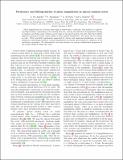Files in this item
Persistence and lifelong fidelity of phase singularities in optical random waves
Item metadata
| dc.contributor.author | De Angelis, L. | |
| dc.contributor.author | Alpeggiani, F. | |
| dc.contributor.author | Di Falco, Andrea | |
| dc.contributor.author | Kuipers, L. | |
| dc.date.accessioned | 2017-11-23T17:30:06Z | |
| dc.date.available | 2017-11-23T17:30:06Z | |
| dc.date.issued | 2017-11-16 | |
| dc.identifier | 251425452 | |
| dc.identifier | 47421742-b1e2-4b0c-b34b-e59335a20f68 | |
| dc.identifier | 85034664566 | |
| dc.identifier | 000415301600010 | |
| dc.identifier.citation | De Angelis , L , Alpeggiani , F , Di Falco , A & Kuipers , L 2017 , ' Persistence and lifelong fidelity of phase singularities in optical random waves ' , Physical Review Letters , vol. 119 , no. 20 , 203903 . https://doi.org/10.1103/PhysRevLett.119.203903 | en |
| dc.identifier.issn | 0031-9007 | |
| dc.identifier.other | ORCID: /0000-0002-7338-8785/work/57821775 | |
| dc.identifier.uri | https://hdl.handle.net/10023/12162 | |
| dc.description | Funding: EPSRC (Grants No. EP/L017008/1 and EP/M000869/1) (ADF) | en |
| dc.description.abstract | Phase singularities are locations where light is twisted like a corkscrew, with positive or negative topological charge, depending on the twisting direction. Among the multitude of singularities arising in random wave fields, some of them can be found at the same location, but only when they exhibit opposite topological charge, which results in their mutual annihilation. New pairs can be created as well. With near-field experiments supported by theory and numerical simulations we study persistence and pairing statistics of phase singularities in random optical fields as a function of the excitation wavelength. We demonstrate how such entities can encrypt fundamental properties of the random fields in which they arise. | |
| dc.format.extent | 3288649 | |
| dc.language.iso | eng | |
| dc.relation.ispartof | Physical Review Letters | en |
| dc.subject | QC Physics | en |
| dc.subject | T Technology | en |
| dc.subject | DAS | en |
| dc.subject.lcc | QC | en |
| dc.subject.lcc | T | en |
| dc.title | Persistence and lifelong fidelity of phase singularities in optical random waves | en |
| dc.type | Journal article | en |
| dc.contributor.sponsor | EPSRC | en |
| dc.contributor.sponsor | EPSRC | en |
| dc.contributor.institution | University of St Andrews. School of Physics and Astronomy | en |
| dc.identifier.doi | 10.1103/PhysRevLett.119.203903 | |
| dc.description.status | Peer reviewed | en |
| dc.identifier.grantnumber | EP/M000869/1 | en |
| dc.identifier.grantnumber | ep/l017008/1 | en |
This item appears in the following Collection(s)
Items in the St Andrews Research Repository are protected by copyright, with all rights reserved, unless otherwise indicated.

